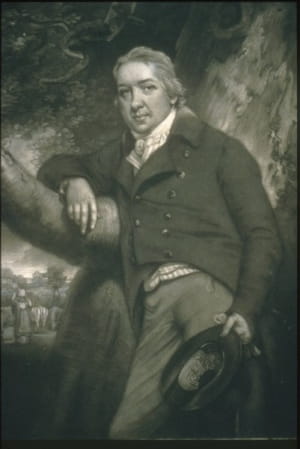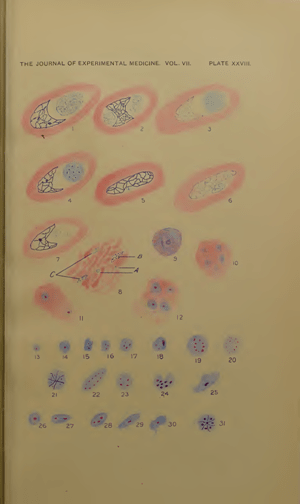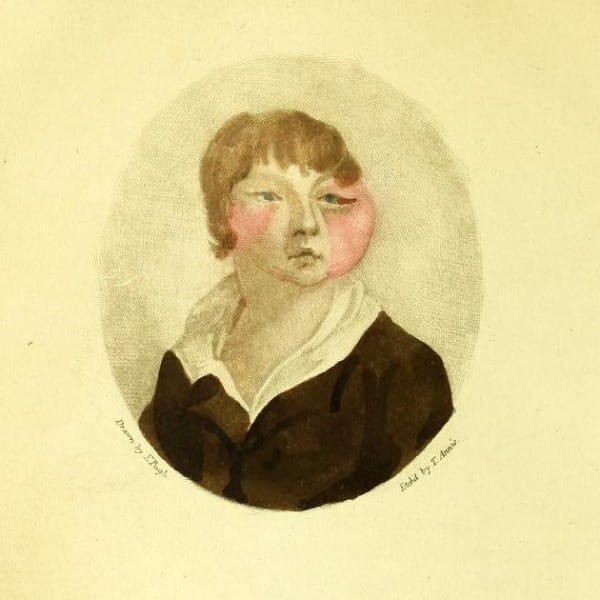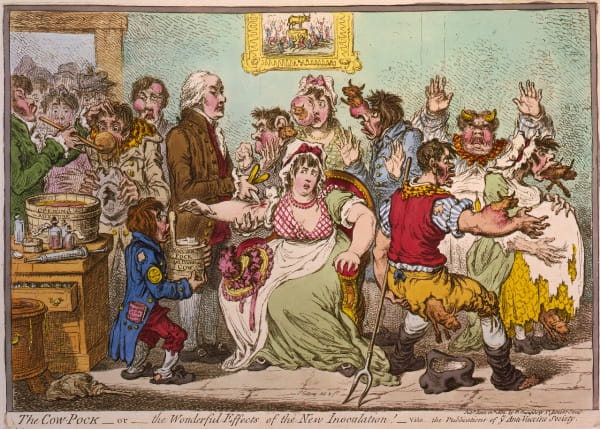Zoobiquity
01 Feb 2019
Corinne Hogan

Edward Jenner pioneered cow pox inoculations which led, in less than 200 years, to smallpox being classed as one of two infectious diseases to have been eradicated, the other being rinderpest in 2011.
Right: Edward Jenner (1749-1823), by Smith, John Raphael, 1752-1812, from the Hunterian Museum (RCSSC/P 1924).
In Jenner’s day, as is also the case now, immunisation was a contentious issue, and the idea of inoculating with a live virus was dismissed as ineffective, murderous or even contrary to the will of God.
Cow-poxed, Ox-faced Boy, E Pugh. From Cow-pox inoculation no security against small-pox infection, by Rowley, William, 1742 or 3-1806 (1805). From the Royal College of Surgeons of England UK Medical Heritage Library collection.
Pamphlets on the subject express a multitude of views, ranging from defensive to vituperative attacks, specifically on Jenner’s use of the animal disease. One of the latter comes from a William Rowley, a midwife and surgeon at St. Thomas’ Hospital, who advocated using live smallpox to inoculate and disagreed with the use of the milder and safer cowpox. His objection to the use of this “filthy disease of beasts” is expressed in this pamphlet available in full text in the RCS contribution to the UKMHL. The work shows illustrations of deformities supposedly produced by vaccination, later satirised in James Gillray’s famous caricature.
The Cow-Pock or the Wonderful Effects of the New Innoculation! by James Gillray (1802). From Wikimedia Commons, original image from the Library of Congress, Public Domain.

Right: Seven to eight million children are thought to have died from measles every year before the vaccine was introduced - a tract from 1905 shows research into the skin samples of fatal cases. From On the presence of certain bodies in the skin and blister fluid from scarlet fever and measles, by Field, Cyrus West (1905). From the Royal College of Surgeons of England UK Medical Heritage Library collection.
In modern times, zoobiquity aims to broaden the emphasis on linking areas of human and animal medicine to include other conditions, like heart disease and the study of genetic and autoimmune diseases, including cancer. An increasing range of treatments that have proven safe for animals, it is argued, could be safe for people as well.
To back this up, there have been some notable successes in the research looking for links with clinical implications for patients both human and animal. River Blindness, HPV and a form of child bone cancer have all been addressed with successful treatments deriving from comparative studies.
However, there have also been notable failures: including a huge number of unsuccessful potential treatments for stroke; a disastrous study using TGN1412 with a view to developing it for leukaemia and other auto-immune diseases; and an HIV trial that produced no benefits in humans after positive effects in monkeys.
Dr. Barbara Natterson-Horowitz, a cardiologist at the UCLA Medical Center, who originally coined the term ‘zoobiquity’ notes that shifts in educational emphasis between generations of medics have influenced understanding of the parallels that can be drawn. The move away from teaching comparative anatomy and pathology in current medical training has arguably endangered the discovery of such comparative links. She notes her father’s experience of these subjects at medical school and the contrasting lack of teaching about them during her own training.
One wonders what Hunter would have thought of such a situation: as the founder of pathological anatomy in England, his studies and experiments in comparative aspects of biology, anatomy, physiology and pathology were profoundly important and influential. The general biological principles learned during his career studying comparatively and applied to his practise of surgery, gave surgery the prestige of a scientific profession. As his epitaph states, he was “a gifted interpreter of the Divine Power and Wisdom at work in the Laws of Organic Life”.
Perhaps Natterson-Horowitz and others like her are inspiring research to come full circle, and we’ll see more of an upswing in this area as time goes on. Getting back to studying and mining the work of animal medicine for potential applications in its human equivalent, and vice versa, are exciting areas to continue in the future, as it seems that when success is realised the results can be incredible. As Hunter exhorted Jenner famously in a letter concerning the latter’s hunch about something: “but why think, why not trie the Expt”.
Corinne Hogan, Senior Information Assistant
Join the discussion
Add your comments to the site using Disqus.
Sign up below by adding a name, email address and password (click on the Discussion box to reveal the 'Name' field). Or log in using your social media profile.
After signing up, you can start commenting and won't have to log in to Disqus again - you don't even need to log in to your RCS account.


